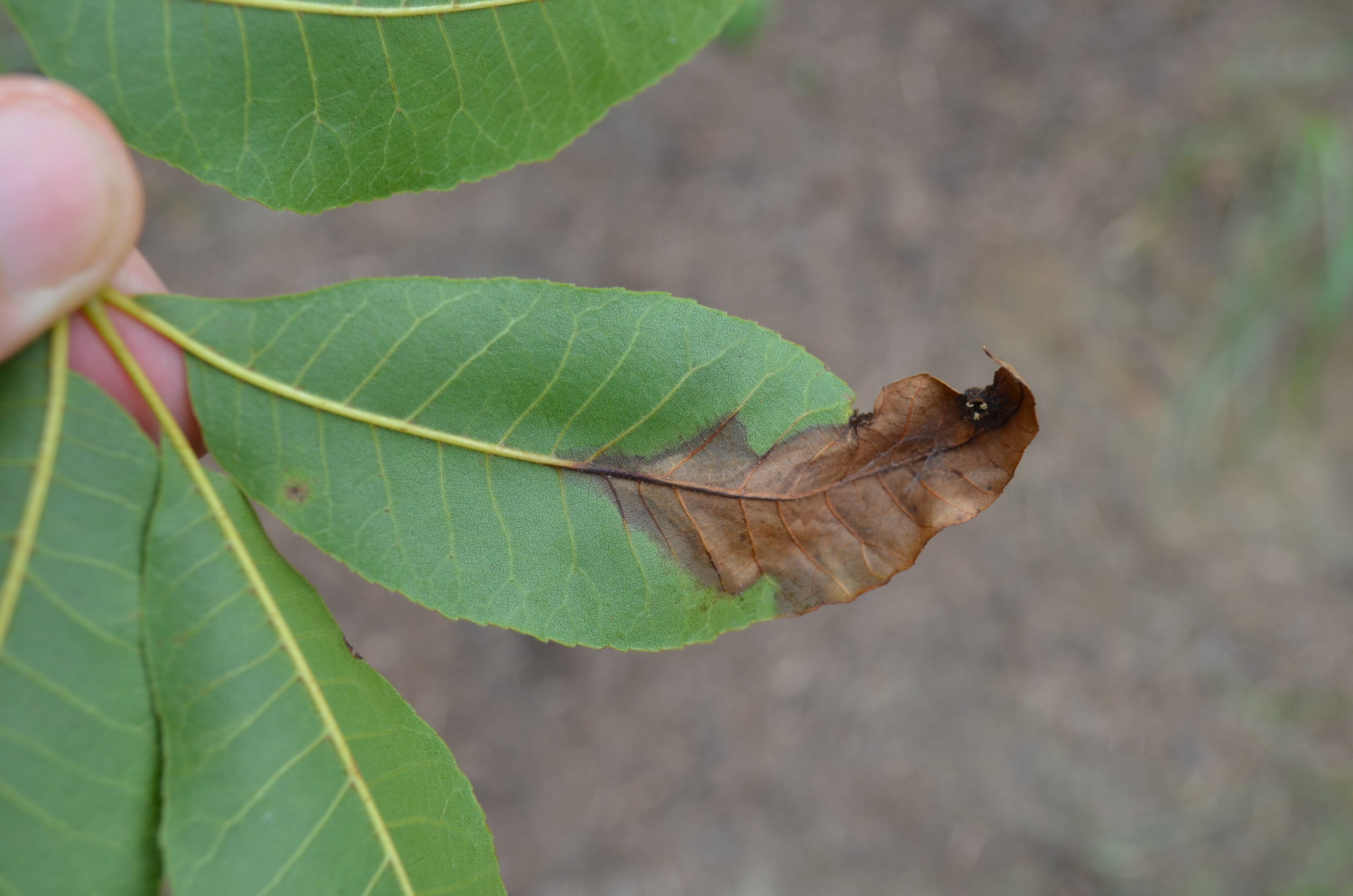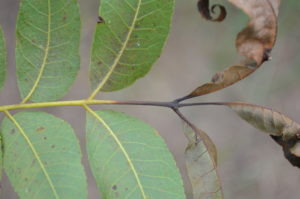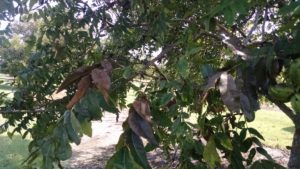Neofusicoccum caryigenum, a new pecan pathogen finally gets a name

Initial symptom of leaf die-back on a single leaflet. (Photo courtesy of Tim Brenneman)
In wet years symptoms were readily apparent on yard trees across southern Georgia that landowners did not spray with fungicides. Originally the disease was called “Terminal die-back,” but it appears to affect only the leaves and is now called “Leaf die-back.” The initial lesion can appear on any of the leaflets on the compound leaf. That entire leaflet becomes necrotic, followed by the rachis where that leaflet is attached. The remaining terminal leaflets beyond that point also become necrotic, and often the infection moves down the leaf rachis to encompass the entire leaf.

Progression of leaf die-back as it colonizes more tissue and moves toward the base of the leaf, eventually killing all leaflets on that leaf. (Photo courtesy of Tim Brenneman)
The necrotic leaflets are light brown or tan, and the infected leaves often persist on the tree for some time, making the disease highly visible if the incidence is very high. The individual leaflets often stay attached, but the entire leaf will eventually drop, thus causing premature defoliation. The pathogen has not been observed to move into the wood or fruit, but early defoliation can be very detrimental to trees that need to store carbohydrates in preparation for growth the following season.

Entire leaves die and turn light brown to tan but often persist in the tree canopy for some time. This symptom is readily visible with even lower levels of infection but can be severe in wet years on non-sprayed trees, resulting in early defoliation of susceptible cultivars. (Photo courtesy of Tim Brenneman)
While there were some initial reports of this symptom in the field (Wells, 2015), it took a while to officially name this disease because it is caused by a previously undescribed pathogen. The fungus causing leaf die-back is now known to be Neofusicoccum caryigenum. Although related to other fungi such as Botryosphaeria (Crous et al. 2006), this species was not previously described, and the symptoms were not previously observed. This pathogen’s origin is unknown, but soon after discovery, we started receiving reports of similar symptoms from other geographic areas around the Southeast. Further investigation demonstrated those symptoms were caused by the same pathogen, and the disease could be easily reproduced in the greenhouse on inoculated leaves of pecan seedlings.
Details of the epidemiology of leaf die-back are scarce. This disease is clearly worse in wet weather, particularly if it occurs early in the growing season as the foliage is developing. Symptoms are sometimes seen as early as May but usually occur later in the growing season. With the demonstrated potential to cause severe defoliation under some circumstances, how much of a threat is this disease to the pecan industry?
Time will tell, but for now, it appears to be an issue primarily for growers that do not apply fungicides. It does not cause massive reductions in crop yield like scab can, but the long-term detrimental effects of severe defoliation on pecan trees are well known.
The great majority of managed commercial pecans in Georgia are sprayed regularly with fungicides for scab. Fortunately leaf die-back seems to respond to most fungicides currently used for pecan scab. While no fungicide trials have been conducted specifically for this disease, ratings have been taken from scab trials at the University of Georgia research orchard in Tifton. The varieties used are either ‘Wichita’ or ‘Desirable.’ Both are susceptible, but ‘Wichita’ usually has a more severe level of damage from leaf die-back or scab. The disease responds well to our standard combination of Tin and Elast for nut scab, as well as the phosphites that we often use pre-pollination. However, the most consistent control comes from the products with multiple modes of action like Absolute, Amistar Top (=Quadris Top), or the recently labeled Miravis Top. Control has been less consistent with straight DMI fungicides like tebuconazole or Enable. This has also been observed with nut scab control, where the problem has been shown to be fungicide-resistant strains of the pathogen. This has never been looked at in Neofusicoccum caryigenum, but with the intensive fungicide exposure in some orchards, resistance to this pathogen is certainly a possibility.
The continued widespread use of integrated fungicide programs will help prevent the spread of resistance, and hopefully, keep Neofusicoccum caryigenum more of a novelty in commercial sprayed orchards. The impact on organic or reduced input orchards is potentially greater. Certainly, more work is needed to quantify current cultivars’ relative susceptibility, especially those selected for low-input production.
This disease’s future impact is uncertain, but it is unlikely to go away anytime soon. But for now, every pecan grower can easily recognize it if it occurs in their orchard. And now you know “the rest of the story”!

